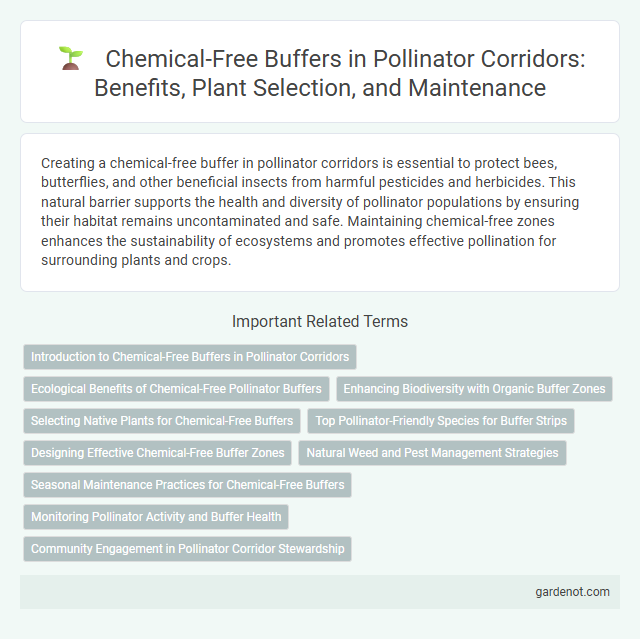Creating a chemical-free buffer in pollinator corridors is essential to protect bees, butterflies, and other beneficial insects from harmful pesticides and herbicides. This natural barrier supports the health and diversity of pollinator populations by ensuring their habitat remains uncontaminated and safe. Maintaining chemical-free zones enhances the sustainability of ecosystems and promotes effective pollination for surrounding plants and crops.
Introduction to Chemical-Free Buffers in Pollinator Corridors
Chemical-free buffers in pollinator corridors serve as critical zones that protect pollinators from harmful pesticides and chemicals, ensuring safer habitats for bees, butterflies, and other beneficial insects. These buffers use native plants and organic methods to enhance biodiversity and promote healthy pollination processes. Maintaining chemical-free zones within pollinator corridors supports ecosystem resilience and boosts agricultural productivity by fostering natural pollination services.
Ecological Benefits of Chemical-Free Pollinator Buffers
Chemical-free pollinator buffers enhance biodiversity by providing safe habitats that support native pollinators such as bees, butterflies, and hummingbirds. These buffers reduce exposure to harmful pesticides, promoting healthier ecosystems and improving pollination efficiency for adjacent crops. The elimination of chemical inputs also preserves soil health and water quality, fostering resilient ecological communities essential for sustainable agriculture.
Enhancing Biodiversity with Organic Buffer Zones
Chemical-free buffer zones create safe habitats for pollinators by eliminating harmful pesticides and promoting organic plant growth, which enhances local biodiversity. These organic buffer strips support diverse native flora that provide essential nectar and pollen sources, fostering healthier pollinator populations. Implementing chemical-free corridors strengthens ecosystem resilience and boosts pollination services critical for agriculture and natural ecosystems.
Selecting Native Plants for Chemical-Free Buffers
Selecting native plants for chemical-free buffers in pollinator corridors enhances habitat quality while minimizing toxic exposure for bees, butterflies, and other pollinators. Native species like milkweed, coneflowers, and goldenrod provide essential nectar and pollen sources that support diverse pollinator populations throughout the growing season. Establishing these chemical-free buffers reduces pesticide drift from adjacent fields, promoting healthier ecosystems and sustainable pollinator conservation.
Top Pollinator-Friendly Species for Buffer Strips
Top pollinator-friendly species for chemical-free buffer strips include native wildflowers like purple coneflower (Echinacea purpurea), black-eyed Susan (Rudbeckia hirta), and bee balm (Monarda fistulosa), which provide essential nectar and pollen. Incorporating flowering grasses such as little bluestem (Schizachyrium scoparium) supports habitat diversity and shelter for pollinators. These species enhance pollinator corridors by sustaining diverse insect populations while maintaining a chemical-free environment to protect pollinator health.
Designing Effective Chemical-Free Buffer Zones
Designing effective chemical-free buffer zones in pollinator corridors involves selecting native plants that provide continuous bloom and habitat connectivity for bees, butterflies, and other pollinators. These zones must be strategically placed to intercept pesticide drift from adjacent agricultural lands, using dense vegetation to create physical and biological barriers. Maintaining diverse, pesticide-free plantings enhances pollinator health and supports ecosystem resilience across fragmented landscapes.
Natural Weed and Pest Management Strategies
Chemical-free buffer zones within pollinator corridors employ natural weed and pest management strategies to protect biodiversity and enhance ecosystem resilience. Techniques such as mulching, companion planting, and habitat creation for beneficial insects reduce reliance on synthetic chemicals, promoting healthy pollinator populations. These practices support sustainable agriculture by maintaining soil health and controlling pests organically throughout the corridor.
Seasonal Maintenance Practices for Chemical-Free Buffers
Seasonal maintenance practices for chemical-free buffers emphasize the removal of invasive species and the careful pruning of native plants to promote pollinator health. Regular monitoring for pest outbreaks allows for early intervention using organic methods, ensuring the buffer remains a safe habitat throughout the year. Implementing mulching and controlled mowing during off-peak pollinator activity supports soil health and flowering plant diversity.
Monitoring Pollinator Activity and Buffer Health
Monitoring pollinator activity within a chemical-free buffer ensures the preservation of native species and enhances biodiversity. Regular assessments of buffer health track floral diversity, pesticide absence, and habitat quality, directly influencing pollinator population stability. Data-driven evaluation supports adaptive management strategies to maintain a thriving pollinator corridor free from chemical contaminants.
Community Engagement in Pollinator Corridor Stewardship
Chemical-free buffers are vital in pollinator corridors, promoting safer habitats by eliminating harmful pesticides and supporting biodiversity. Community engagement in stewardship fosters local ownership and collective action, ensuring sustained maintenance and monitoring of these green spaces. Active participation from residents, schools, and organizations strengthens the corridor's ecological function and enhances pollinator health through education and volunteer efforts.
Chemical-free buffer Infographic

 gardenot.com
gardenot.com